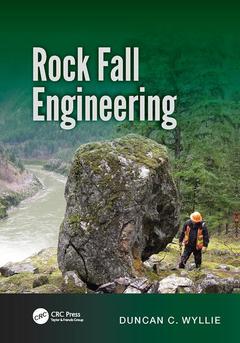Description
Rock Fall Engineering
Author: Wyllie Duncan C.
Language: English
Subjects for Rock Fall Engineering:
Keywords
Rock Fall; Rock Fall Impacts; Rock Falls – Causes And Consequences; Rock Fall Behavior; Impacts On Rock Slopes; Tangential Coefficient; Rock Fall Velocities And Trajectories; Rock Fall Paths; Energy Changes During Impacts And Trajectories; Rock Slopes; Terrain Model – Two Dimensional V Three Dimensional Analysis; Impact Point; Impact Energy; Rock Fall Hazard; Rock; Trajectory Heights; Rock Fall Modeling; Rock Fall Fences; Rock Sheds; Case Study; Rock Bolts; Guy Wires; Oblique Impact; Impact Normal Velocity; Normal Coefficient; Angular Velocity; Rock Fall Protection; Rock Fall Events; MSE Wall; Tangential Velocity
Publication date: 04-2017
· 17.8x25.4 cm · Paperback
Publication date: 11-2014
262 p. · 17.8x25.4 cm · Hardback
Description
/li>Contents
/li>Readership
/li>Biography
/li>
Rock falls can be a public safety issue. This book provides comprehensive information on identification of these hazards, and design and construction of protection methods.
Rock Fall Engineering
The book covers four main topics as follows:
- Describes causes of rock falls, including geology, climate and topography, and provides detailed documentation on rock fall impacts and trajectories at five sites with a wide variety of topographic and geologic features
- Discusses theory of impact mechanics, and its application to velocity and energy changes during impacts and trajectories
- Reviews methods of modeling rock fall events, and presents analyses for the five case studies
- Examines rock fall protection in terms of selecting appropriate method(s) for site conditions, and design principles in which the objective is to absorb impact energy in an efficient manner
This book, which contains many worked examples, is of interest to practitioners and researchers working in the fields of geological engineering and natural hazards.
Duncan C. Wyllie
Rock Falls—Causes and Consequences. Documentation of Rock Fall Events. Rock Fall Velocities and Trajectories. Impact Mechanics. Coefficient of Restitution. Energy Changes during Impacts and Trajectories. Rock Fall Modeling. Selection of Protection Structures. Design Principles of Rock Fall Protection Structures. Rock Fall Protection I—Barriers, Nets, and Fences. Rock Fall Protection II—Rock Sheds. Appendices: Impact Mechanics—Normal Coefficient of Restitution, Impact Mechanics—Impact of Rough, Rotating Bodies, Energy Loss Equations, Conversion Factors. References.
Duncan C. Wyllie has a physics degree from the University of London and engineering degrees from the University the New South Wales, Australia and the University of California, Berkeley. He is a principal with Wyllie & Norrish Rock Engineers in Vancouver, Canada, and a registered professional engineer in British Columbia. Duncan Wyllie has lectured widely and has also authored or co-authored a number of textbooks on applied rock mechanics including Foundations on Rock (1st and 2nd editions in 1989 and 2001), and Rock Slope Engineering, Fourth Edition (2002), both published by Taylor & Francis.



